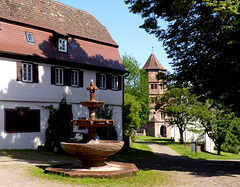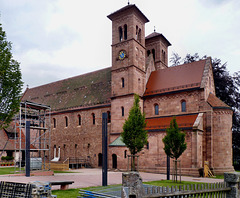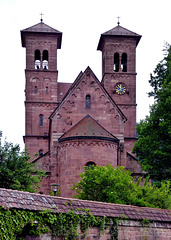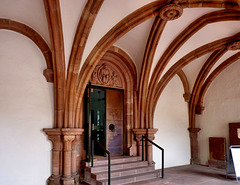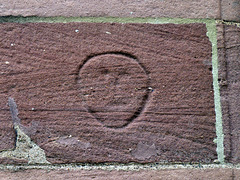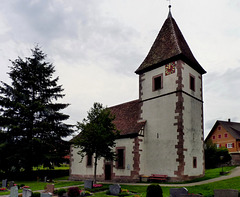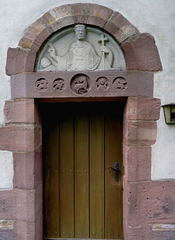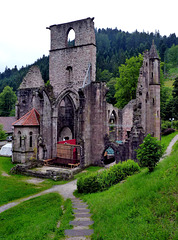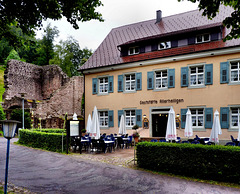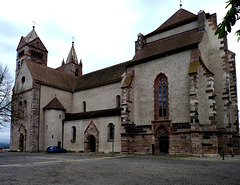
Baden Wuerttemberg
All the photos of this set were taken in Baden-Wuerttemberg, in the south west of Germany..
Hirsau - Abbey
| |
|
Twenty years after Pope Leo IX had asked his nephew Count Adalbert of Calw to rebuild the ruined abbay St. Aurelius, this abbey got a young abbot. Wilhem von Hirsau (aka "William of Hirsau"), educated at St. Emmeram in Regensburg, a very well known "thinktank". Immidietly tried to gain independence of all secular powers for the abbey. At that time, he was probably influenced by the idea, that had spread from Gorze Abbey in Lorraine. He was a strong supporter of the Pope during the Investiture Controversy. Already in 1082 he commissioned the building of a new monastery on a nearby high plateau. In 1091 the abbey church, modelled on Cluny II and dedicated to Peter an Paul, got consecrated.
The convent followed 1092 and moved into a monastic compound designed according to the Plan of Saint Gall. Wilhelm´s friend Ulrich (aka "Ulrich von Zell", "Ulrich von Cluny"), a schoolmate from St. Emmeram, had made carreer in Burgundy and was an advisor to Abbot Hugh of Cluny. So the Cluniac reform found their way into the Black Forest. Based on them Wilhelm wrote down the "Consuetudines Hirsauginenses". Known as the "Hirsau Reforms", the adoption of these rules revitalised Benedictine life throughout Germany - and were followed by far more than 100 monasteries.
Based on a thriving economy most of the romanesque buildings (but not the church!) were demolished and got replaced by gothic style structures. Shortly after that, the Reformation put an end to the abbey in 1536, when the monks had to leave - and a Protestant school was opend here (just like in Maulbronn!).
The "Duke of Wuerttemberg" replaced the old abbot´s house by a posh hunting palace around 1590.
During the Nine Years' War (aka "War of the Palatine Succession") the infamous General Ezéchiel de Mélac burnt the abbey down (like he did with Heidelberg, Worms, Speyer..). The ruins were used as a quarry - and so there is not really much left of this great and important abbey.
The fountain reminds on the fountain in the cloister of Maulbronn. On the right is the tower over the old portal of the monastery.
Herrenalb - Abbey
| |
|
The Cistercian monastery "Alba Dominorum" was founded here in 1149. It was settled by monks from Neubourg Abbey in Alsace (80kms west). The abbey was severely damaged during the German Peasants' War of 1525 and after the Reformation the remaining monks were forced to leave the abbey, that got secularized (and converted in a school for a short time).
The once large abbey church now is "cut" in two different structures. Behind the the ruins of the narthex ("Paradies") in the foreground stands the Lutheran parish church, created out of the old Gothic choir in 1739.
Klosterreichenbach - Monastery
| |
|
The Reichenbach Monastery ("Kloster Reichenbach") was founded in 1082 as the first priory of Hirsau Abbey. Abbot Wilhelm of Hirsau sent eight monks from Hirsau, to settle the place. The building of the church must have started immediately as already three years later the church, dedicated to Gregory the Great, got consecrated. It is hard to imagine, that the church seen today, was built within only three years, but it may well be, that the Bishop of Konstanz consecrated, while the work was still in progress.
The priory existed upto the Reformation, when the whole area turned Protestant. Today the church is the parochial Lutheran church of Klosterreichenbach.
The structure went through two large rebuildings/renovations. According to Heinfried Wischermann ("Romanik in Baden Wuerttemberg") the eastern apses were rebuilt during the first in 1894/95. The blue clock face - and the surrounding ornaments are from that time probably as well.
Klosterreichenbach - Monastery
| |
|
The Reichenbach Monastery ("Kloster Reichenbach") was founded in 1082 as the first priory of Hirsau Abbey. Abbot Wilhelm of Hirsau sent eight monks from Hirsau, to settle the place. The building of the church must have started immediately as already three years later the church, dedicated to Gregory the Great, got consecrated. It is hard to imagine, that the church seen today, was built within only three years, but it may well be, that the Bishop of Konstanz consecrated, while the work was still in progress.
The priory existed upto the Reformation, when the whole area turned Protestant. Today the church is the parochial Lutheran church of Klosterreichenbach.
The structure went through two large rebuildings/renovations. According to Heinfried Wischermann ("Romanik in Baden Wuerttemberg") the eastern apses were rebuilt during the first in 1894/95. The blue clock face - and the surrounding ornaments are from that time probably as well.
Klosterreichenbach - Monastery
| |
|
The Reichenbach Monastery ("Kloster Reichenbach") was founded in 1082 as the first priory of Hirsau Abbey. Abbot Wilhelm of Hirsau sent eight monks from Hirsau, to settle the place. The building of the church must have started immediately as already three years later the church, dedicated to Gregory the Great, got consecrated. It is hard to imagine, that the church seen today, was built within only three years, but it may well be, that the Bishop of Konstanz consecrated, while the work was still in progress.
The priory existed upto the Reformation, when the whole area turned Protestant. Today the church is the parochial Lutheran church of Klosterreichenbach.
The small narthex was completed around 1200 and is probably influenced by the (more elegant) architecture seen in Maulbronn.
Klosterreichenbach - Monastery
| |
|
The Reichenbach Monastery ("Kloster Reichenbach") was founded in 1082 as the first priory of Hirsau Abbey. Abbot Wilhelm of Hirsau sent eight monks from Hirsau, to settle the place. The building of the church must have started immediately as already three years later the church, dedicated to Gregory the Great, got consecrated. It is hard to imagine, that the church seen today, was built within only three years, but it may well be, that the Bishop of Konstanz consecrated, while the work was still in progress.
The priory existed upto the Reformation, when the whole area turned Protestant. Today the church is the parochial Lutheran church of Klosterreichenbach.
The sober nave (seen from the organ loft) has often been compared with St. Aureius in Hirsau, as Monks from Hirsau built this. It was completed in 1178, nearly a hundred years after the consecration of the church.
Klosterreichenbach - Monastery
| |
|
The Reichenbach Monastery ("Kloster Reichenbach") was founded in 1082 as the first priory of Hirsau Abbey. Abbot Wilhelm of Hirsau sent eight monks from Hirsau, to settle the place. The building of the church must have started immediately as already three years later the church, dedicated to Gregory the Great, got consecrated. It is hard to imagine, that the church seen today, was built within only three years, but it may well be, that the Bishop of Konstanz consecrated, while the work was still in progress.
The priory existed upto the Reformation, when the whole area turned Protestant. Today the church is the parochial Lutheran church of Klosterreichenbach.
The choir may be similar to that one of St. Aureius in Hirsau, where it is lost.
Klosterreichenbach - Monastery
| |
|
The Reichenbach Monastery ("Kloster Reichenbach") was founded in 1082 as the first priory of Hirsau Abbey. Abbot Wilhelm of Hirsau sent eight monks from Hirsau, to settle the place. The building of the church must have started immediately as already three years later the church, dedicated to Gregory the Great, got consecrated. It is hard to imagine, that the church seen today, was built within only three years, but it may well be, that the Bishop of Konstanz consecrated, while the work was still in progress.
The priory existed upto the Reformation, when the whole area turned Protestant. Today the church is the parochial Lutheran church of Klosterreichenbach.
Of course the priory had a cloister. Here is the last remaining part of the cloister, now used as a storage room.
Klosterreichenbach - Monastery
| |
|
The Reichenbach Monastery ("Kloster Reichenbach") was founded in 1082 as the first priory of Hirsau Abbey. Abbot Wilhelm of Hirsau sent eight monks from Hirsau, to settle the place. The building of the church must have started immediately as already three years later the church, dedicated to Gregory the Great, got consecrated. It is hard to imagine, that the church seen today, was built within only three years, but it may well be, that the Bishop of Konstanz consecrated, while the work was still in progress.
The priory existed upto the Reformation, when the whole area turned Protestant. Today the church is the parochial Lutheran church of Klosterreichenbach.
There are a couple of carved graffiti in and outside the church. Here is a weathered portrait of an egghead.
Heselbach - St. Peter
| |
|
Not much is known about this place, just 2kms north of the Reichenbach Monastery ("Kloster Reichenbach"). Since 1289 Heselbach was a property of the priory and the small church (11,45 m long) was probably built by the monks. According to Reinhard Wischermann ("Romanik in Baden Wuerttemberg") the church may be dedicated to St. Peter. The structure may seem humble, but it does have a very elaborate portal, taking in account the size and the remoteness of the settlement.
Heselbach - St. Peter
| |
|
Not much is known about St. Peter, just 2kms north of the Reichenbach Monastery ("Kloster Reichenbach"). Heselbach was a property of the priory and the small church, with this elaborate poartal, was probably built by the monks end of the 12th century.
In the center of the lintel, between the symbols of the four evangelists, the Lamb of God ("Agnus Dei").
The tympan depicts God, crowned and holding a cross as a scept in his left hand, while his right is in a blessing gesture. Below this hand is a person rising from the ground. Probably the Last Judgement.
Mummelsee
| |
|
|
During a coffee-break I found this special offer near the parking lot at Mummelsee. A real bargain, but unfortunately I really didn't need a witch that day.
Oppenau - Kloster Allerheiligen
| |
|
Kloster Allerheiligen ("All Saints' Abbey") was a Premonstratensian monastery founded in 1192 by the regional nobilty. It had a long history as an abbey, even survived the Reformation, but in 1802 Margrave Karl Friedrich of Baden dissolved the abbey and took its possessions. All monks had to leave, and after a factory, that had been established here, failed, the whole complex fell into ruins and got sold as a quarry.
Meanwhile, British aristocracy had invented tourism, sailed the Rhine up and down and climbed onto swiss mountains. The Romantic Period started in Germany and painters like Caspar David Friedrich made "lonely ruins in fog" a theme of many works of art. Printer Karl Baedeker opened a publishing house in Koblenz. The title of his first bestseller was "Rheinreise von Mainz bis Koeln" ("Travelling the Rhine from Mainz to Cologne"). From then on Mr. Baedecker focussed very sucessfully on guidebooks.
First tourists hiked up the valley to see the ruins and about 1840 a guesthouse was opened, to offer beer and limonade... In 1853 Mr. Baedecker himself visited the place - and wrote about the romantic ruins and the wonderful waterfalls nearby.
In 1871 the guesthouse got rebuilt into a posh hotel. Samuel Langhorne Clemens (aka "Mark Twain"), traveling through Europe, probably read Baedecker´s guidebook and so visited the ruins in 1878. He wrote about it in "A Tramp Abroad" (part of this book is the essay "The Awful German Language").
Today the place seems a little forgotten again, though as in so many ruins and as in front of so many Romanesque churches - during summer there is a stage here.
Oppenau - Kloster Allerheiligen
| |
|
Kloster Allerheiligen ("All Saints' Abbey") was a Premonstratensian monastery founded in 1192 by the regional nobilty. It had a long history as an abbey, even survived the Reformation, but in 1802 Margrave Karl Friedrich of Baden dissolved the abbey and took its possessions. All monks had to leave, and after a factory, that had been established here, failed, the whole complex fell into ruins and got sold as a quarry.
Meanwhile, British aristocracy had invented tourism (via the more old fashioned "Grand Tour"), sailed the Rhine up and down and climbed onto swiss mountains. The Romantic Period started in Germany and painters like Caspar David Friedrich made "lonely ruins in fog" a theme of many works of art. Printer Karl Baedeker opened a publishing house in Koblenz. The title of the first bestseller he published was "Rheinreise von Mainz bis Köln" ("Travelling the Rhine from Mainz to Cologne"). From then on Mr. Baedecker focussed sucessfully on guidebooks.
First tourists hiked up the valley to see the ruins and about 1840 a guesthouse was opened, to offer beer and limonade... In 1853 Mr. Baedecker himself visited the place - and wrote about the romantic ruins and the wonderful waterfalls nearby.
In 1871 the guesthouse got rebuilt into a posh hotel. Samuel Langhorne Clemens (aka "Mark Twain"), traveling through Europe, probably read Baedecker´s guidebook and so visited the ruins in 1878. He wrote about it in "A Tramp Abroad" (part of this book is the essay "The Awful German Language").
Especially on a rainy day, the whole place seems a little forgotten again, but the guesthouse/ hotel where Mark Twain had a trout, still exists. He wrote
"A big hotel crowds the ruins a little, now, and drives a brisk trade with summer tourists. We descended into the gorge and had a supper which would have been very satisfactory if the trout had not been boiled."
www.gutenberg.org/files/119/119.txt
Glottertal - St. Blasien
| |
|
As the legend says, that Saint Christopher was a giant, most sculptures or frescoes depicting him - are somehow oversized. This one is on the neo-gothic parish church St. Blasius in Glottertal.
Breisach - Muenster St. Stephanus
| |
|
St. Stephanus towers on a hill over the little town of Breisach. The steep hill, once an island in the middle of the Rhine, housed a Celtic settlement, before in 369 the Romans founded "Mons Brisiacus", a castle, maintained still in the 5th century against the hostile Alemanni. A settlement on the hill existed throughout early medieval times and the town of Breisach was founded by the Staufer in 1185. It was taken over soon after by the House of Zaehringen, followed by the Bishop of Basel, followed by the House of Habsburg, followed....
The construction of the Muenster was probably started after 1185, replacing a smaller church that was carolingian or even merovingian. What is seen today is the result of centuries of building and rebuilding. Started in late romanesque style and "completed" already 1230/1240, a gothic choir was added still within the 13th century. After 1330 the construction of the western part started. It took 200 years, to complete it. The last small towers were added in 1785.
The architecturally heterogeneous church has a very rich furnishing. There is a fantastic, high gothic choir screen, a triptych, created by an unknown scholar of Hans Baldung (who himself was one of Albrecht Durer’s students), a huge (100m²) "Last Judgment"-fresco by Martin Schongauer ("Madonna im Rosenhag") and there is a shrine containing the relics of Saints Gervasius and Protasius, once brought to Breisach by Archbishop Rainald von Dassel.
A legend tells, that Rainald von Dassel was on his way back to Cologne after he and his friend Barbarossa had looted Milano in 1162. The relics he left here were part of the loot. The most important and valuable loot had, were the relics of the Magis, which he brought home to Cologne, where they still are.
So a lot of interesting and fantastic works of art to find inside the church - BUT - unfortunately it is not allowed to take photos inside. I accept easily the NO FLASH, what (see Freiburg) sometime leads to bad results, but NO PHOTOS is - bad! In case a member of the parish or the Tourist Office reads this - please ask the persons in charge to rethink the decision. I would come back!
Freiburg - Muenster
| |
|
The city of Freiburg was founded by the Dukes of Zaehringen in 1120. The town was located at a junction of old trade routes and already in 1200 the population had risen to 6000. This was, when under Bertold V the last duke of Zaehringen, the construction of the Freiburg Muenster cathedral began, replacing an older parish church. The blueprint of the church "Muenster Unserer Lieben Frau" was very ambitious, but Freiburg was a very prosperous place, as silver mining in the nearby Black Forrest was thriving. The building of the cathedral begun in the Romanesque style and was continued and completed 1513 for the most part as a Gothic cathedral.
The cathedral is 116 meters long, 30 meters wide and the tower (seen here only under scaffolding) is 116 meters high. This tower (completed 1330) was one the highest in Germany during medieval times. The higher towers in Ulm, Cologne, Hamburg etc. were all completed within then 19th century.
Freiburg Muenster is often been compared to Basel Muenster (60kms south), as "Basel III" is not much older. Colmar (45kms west) and Strasbourg (80kms northwest) were in a process of building large romanesque/gothic churches. Not mentioning Breisach, Rouffach, Schlettstadt...There was quite some competition.
The market is still held around the cathedral. That has not changed since the early times.
St. Peter - St. Peter
| |
|
What is the parish church of the village St. Peter (pop. 2400) was once the church of the Benedictian abbey "St. Peter auf dem Schwarzwald" ("Saint Peter in the Black Forest").
Architect Peter Thumb, who has worked as well in Schwarzach, designed this baroque church, built 1724/27. Below this church are probably the foundations of a large romanesque church, as the monastery got founded already 1093 by Berthold I of Zaehringen (see "Freiburg") as a "family monastery" for the House of Zaehringen. It was part of the monastical reformation, that Bernhard of Hirsau had triggered, influenced by Cluniac ideas. Over the centuries the abbey burnt down four times and went through hard times, but existed upto 1806, when it got dissolved in the secularisation. Most buildings of the large (baroque) monastery complex still exist - now used for the local administration and a seminary.
Jump to top
RSS feed- Latest items - Subscribe to the latest items added to this album
- ipernity © 2007-2024
- Help & Contact
|
Club news
|
About ipernity
|
History |
ipernity Club & Prices |
Guide of good conduct
Donate | Group guidelines | Privacy policy | Terms of use | Statutes | In memoria -
Facebook
Twitter

